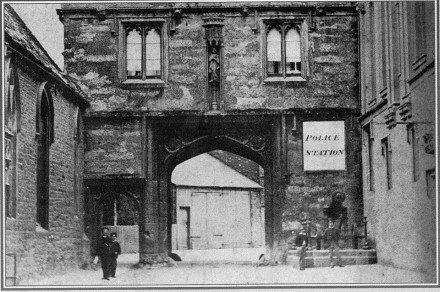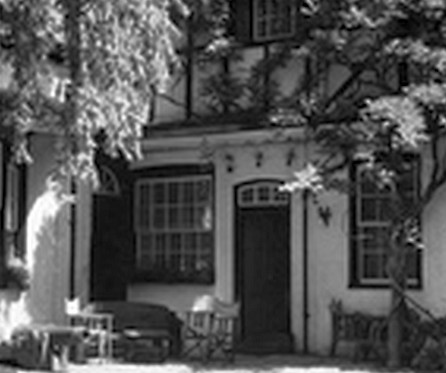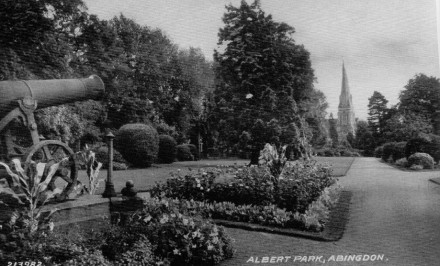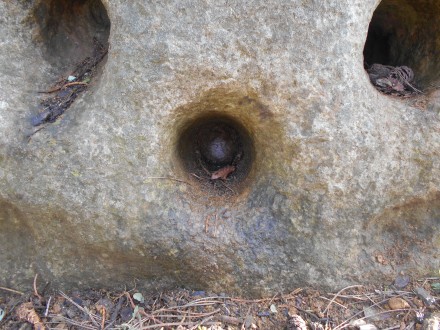Thank you to Steve for this (pictures from his postcards all rights reserved) …
I know of three cannons that were on display in Abingdon, all of which, I am told by long gone family members, were captured during the Crimean War. Two were taken away for scrap metal in the 2nd World War.

The first was on a plinth in front of the walk-way under the arch by St Nicolas church. (There is much loved tradition of holding your breath while going under the arch. Failing to do so turns you into one of the stone gargoyles above it.)

The second and much smaller was in the court yard of the Crown & Thistle and I vaguely remember this one.

The third and most impressive sat on a purpose made plinth in Albert park. I remember the now gone empty plinth and the inscription “Sevastopol” upon it.

Thinking of cannons brings this boulder to mind. It is in the Abbey gardens next to Trendell’s Folly. Look carefully and you can see cannon balls embedded in it. We were told they were from the civil war but i’m not so sure. The rock doesn’t resemble anything else in Abingdon which makes me wonder if Mr Trendell, rich as he was, had the boulder, complete with cannon balls, brought in to enhance his folly.
I lost count of the number of pen knife blades I broke trying to get one out!
Really fascinating.
there is still one in the courtyard of The Crown and Thistle, not sure if the original, but has been there for many years though
Jumping off the plinth in Albert Park was a regular feature of walking into town …
The gateway cannon and the Albert Park cannon were the same one. The one at the Crown and Thistle is a carronade or gunnade with trunions. This type were often used on merchant ships.
Isn’t there an old local story/rumour/hearsay/old wives tale of one of the cannons being buried somewhere in one of the parks in the town.
I’d always understood that if you didn’t hold your breath under the bridge the gargoyles would come and take it (your breath) away.
Looking closely at the first and last pictures both the cannon and plinth are very similar if not the same, is it not the case that the one from the Abbey gateway was relocated to Albert Park? the alternative being that as with much mass production the artillery pieces are the same from the same conflict (there are or were many others in the U.K.) and possibly the plinth was supplied by the same local stone mason… who knows… I’m sure one of the local historians would know the answer.
The one in the Crown & Thistle looks in need of some TLC. The wooden cradle it’s on has fallen apart so it’s sat at a jaunty angle.
Some interesting comments, it may be the Royal Berks Regiment museum has the answer? Back then we were in Berkshire and may have been captured and brought back by our home regiment ? I was fortunate enough to visit Sevastopol and Balaclave 5 years ago, stood on the spot where Lord Raglan ordered the infamous charge of the light brigade and visited the amazing diarama in Sevastopol museum depicting Florence Nightingale-also, didn’t we have our own F N there looking after the wounded? A nurse from Abingdon who tended the dying and wounded on the front line?
Is the local Loose Cannon Brewery named so because of the cannons in this article?
You have to hop whilst holding your breath while going under the archway – or you’ll marry one of the gargoyles!
Thanks for the info explaining why i was taught, and continue to teach others, to hop whilst holding breath under the Abbey archway.